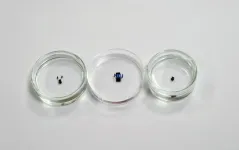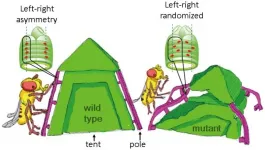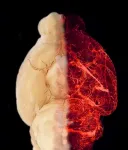(Press-News.org) A team of scientists at Nanyang Technological University, Singapore (NTU Singapore) has developed millimetre-sized robots that can be controlled using magnetic fields to perform highly manoeuvrable and dexterous manipulations. This could pave the way to possible future applications in biomedicine and manufacturing.
The research team created the miniature robots by embedding magnetic microparticles into biocompatible polymers -- non-toxic materials that are harmless to humans. The robots are 'programmed' to execute their desired functionalities when magnetic fields are applied.
The made-in-NTU robots improve on many existing small-scale robots by optimizing their ability to move in six degrees-of-freedom (DoF) - that is, translational movement along the three spatial axes, and rotational movement about those three axes, commonly known as roll, pitch and yaw angles.
While researchers have previously created six DoF miniature robots, the new NTU miniature robots can rotate 43 times faster than them in the critical sixth DoF when their orientation is precisely controlled. They can also be made with 'soft' materials and thus can replicate important mechanical qualities -- one type can 'swim' like a jellyfish, and another has a gripping ability that can precisely pick and place miniature objects.
The research by the NTU team was published in the peer-reviewed scientific journal Advanced Materials in May 2021 and is featured as the front cover of the June 10 issue.
Lead author of the study, Assistant Professor Lum Guo Zhan from the School of Mechanical and Aerospace Engineering said the crucial factor that led to the team's achievement lie in the discovery of the 'elusive' third and final principal vector of these magnetic fields, which is critical for controlling such machines.
By contrast, previous works had only defined the applied magnetic fields in terms of two principal vectors.
"My team sought to uncover the fundamental working principles of miniature robots that have six-DoF motions through this work. By fully understanding the physics of these miniature robots, we are now able to accurately control their motions. Furthermore, our proposed fabrication method can magnetise these robots to produce 51 to 297 folds larger six-DoF torques than other existing devices. Our findings are therefore pivotal, and they represent a significant advancement for small-scale robotic technologies," explains Asst Prof Lum.
Remote-controlled miniature robots suitable for surgical, manufacturing use
Measuring about the size of a grain of rice, the miniature robots may be used to reach confined and enclosed spaces currently inaccessible to existing robots, say the NTU team, making them particularly useful in the field of medicine.
The movements of the robots can be controlled remotely by an operator, using a programme running on a control computer that precisely varies the strength and direction of magnetic fields generated by an electromagnetic coil system.
The miniature robots may also inspire novel surgical procedures for 'difficult-to-reach' vital organs such as the brain in future, the NTU team said, adding that much more work and testing still need to be accomplished before the miniature robots can eventually be deployed for their targeted medical applications.
Co-authors of the research, PhD students Xu Changyu and Yang Zilin from the School of Mechanical and Aerospace Engineering said, "Besides surgery, our robots may also be of value in biomedical applications such as assembling lab-on-chip devices that can be used for clinical diagnostics by integrating several laboratory processes on a single chip."
NTU miniature robots swim through barriers, assemble structures
In lab experiments, the research team demonstrated the dexterity and speed of the miniature robots.
Using a jellyfish inspired robot, the NTU team showed how it was able to swim speedily through a tight opening in a barrier when suspended in water. This demonstration was highly significant as it suggested that these robots were able to negotiate barriers in dynamic and uncertain environments and this could be a highly desirable ability for their targeted biomedical applications in future such as in surgical procedures for 'difficult-to-reach' vital organs such as the brain.
Demonstrating precise orientation control, the miniature robot also recorded a rotation speed of 173 degrees per second for their sixth DoF motion, exceeding the fastest rotation that existing miniature robots have achieved, which is four degrees per second for their sixth DoF motion.
With their gripper robot, the scientists were able to assemble a 3D structure consisting of a bar sitting atop two Y-shaped stilts in less than five minutes, about 20 times faster than existing miniature robots have been able to. This proof-of-concept demonstration, say the researchers, suggests that one day they may be used in 'micro factories' that build microscale devices.
Providing an independent view, Professor Huajian Gao, a Distinguished University Professor from the School of MAE at NTU, and a recipient of the prestigious 2021 American Society of Mechanical Engineers Timoshenko Medal, said, "This is a perfect example of how engineering ingenuity rooted in deep scientific understanding helps us develop advanced robotics for the benefit of mankind. This research work can have profound impact in many fields ranging from novel surgical methods to small scale assembly processes in future manufacturing."
The NTU team is now looking to make their robots even smaller, on the scale of a few hundred micrometres, and to ultimately make the robots fully autonomous in terms of control.
INFORMATION:
Is artificial intelligence the key to preventing relapse of severe mental illness?
New AI software developed by researchers at Flinders University shows promise for enabling timely support ahead of relapse in patients with severe mental illness.
The AI2 (Actionable Intime Insights) software, developed by a team of digital health researchers at Flinders University, has undergone an eight-month trial with psychiatric patients from the Inner North Community Health Service, located in Gawler, South Australia.
The digital tool is tipped to revolutionise consumer-centric timely mental health treatment provision outside hospital, with researchers labelling it as readily available and scalable.
In the trial of 304 ...
Exposure to the rhinovirus, the most frequent cause of the common cold, can protect against infection by the virus which causes COVID-19, Yale researchers have found.
In a new study, the researchers found that the common respiratory virus jump-starts the activity of interferon-stimulated genes, early-response molecules in the immune system which can halt replication of the SARS-CoV-2 virus within airway tissues infected with the cold.
Triggering these defenses early in the course of COVID-19 infection holds promise to prevent or treat the infection, ...
Researchers from The Australian National University (ANU) have developed new technology that allows people to see clearly in the dark, revolutionising night-vision.
The first-of-its-kind thin film, described in a new article published in Advanced Photonics, is ultra-compact and one day could work on standard glasses.
The researchers say the new prototype tech, based on nanoscale crystals, could be used for defence, as well as making it safer to drive at night and walking home after dark.
The team also say the work of police and security guards - who regularly employ night vision - will be easier and safer, reducing chronic neck injuries from currently bulk night-vision devices.
"We have made the invisible visible," lead researcher Dr Rocio Camacho Morales said. ...
Data collected for over two decades shows that rising Baltic Sea water temperature is one of the main factors in the increasingly earlier appearance and faster growth of Baltic herring larvae.
Baltic herring (Clupea harengus membras) is commercially the most important fish species in Finland, and an important part of the Baltic marine ecosystem. Conditions during herring spawning may have cascading effects on the whole Baltic ecosystem.
According to a recent research, both developmental stages in Baltic herring larvae, small and large, have shifted their timing to earlier dates.
"This suggests that herring spawn earlier and larvae grow faster, by about 7.7 days per decade. Water ...
Rising numbers of liver cancer in Aboriginal and Torres Strait Islander communities has led experts at Flinders University to call for more programs, including mobile liver clinics and ultrasound in rural and remote Australia.
The Australian study just published in international Lancet journal EClinicalMedicine reveals the survival difference was largely accounted for by factors other than Indigenous status - including rurality, comorbidity burden and lack of curative therapy.
The study of liver cancer, or Hepatocellular carcinoma (HCC), included 229 Indigenous and 3587 non-Indigenous HCC cases in South Australia, Queensland and the ...
Osaka, Japan - On the outside, animals often appear bilaterally symmetrical with mirror-image left and right features. However, this balance is not always reflected internally, as several organs such as the lungs and intestines are left-right (LR) asymmetrical. Researchers at Osaka University, using an innovative technique for imaging movement of cell nuclei in living tissue, have determined the patterns of nuclear alignment responsible for LR-asymmetrical shaping of internal organs in the developing embryo.
Embryogenesis involves complex genetic and molecular processes that transform a single-celled zygote into a complete, living individual with multiple functional axes, including the LR axis. A long-standing conundrum of Developmental ...
Researchers at the University of Helsinki and the Beatson Institute for Cancer Research in Glasgow have discovered how mutated cells promote their chances to form cancer. Typically, the accumulation of harmful cells is prevented by active competition between multiple stem cells in intestinal glands, called crypts.
"The functioning of intestinal stem cells relies on growth factors, named Wnts, produced by the surrounding environment. Intestinal cancers typically originate from stem cells where mutations allow growth independent of these factors. When we removed a gene called Notum, which renders Wnts inactive, from mutated stem cells, the number of precancerous adenomas in the intestine was greatly reduced. We found that ...
Echoing through history by reviving fungal specimens originally preserved and described a flabbergasting quarter of a millenium ago by the "Father of Modern Taxonomy" Carl Linnaeus, this study highlights the untapped potential of museum collections in modern research programmes. The results have just been published in the renowned Cell Press journal iScience.
The "desert coprinus" fungus Podaxis has fascinated scientists and explorers for centuries, still the genus has been subjected to relatively little research. These large mushrooms thrive in hostile and mostly species-free environments and while they occur seasonally ...
Hypertension is a widespread comorbidity of patients with obesity that greatly increases the risk of mortality and disability. In recent years, researchers have found that a high-calorie diet increases the density of blood vessels (hypervascularization) in the hypothalamus - an important "eating control" area in our brain. Researchers hypothesized that elevated hormone levels of leptin are associated with a higher risk of developing hypertension. However, the exact mechanisms that contribute to the condensed growth of blood vessels in the hypothalamus were unknown.
New research conducted by Cristina García-Cáceres' research group at Helmholtz Zentrum ...
Solar activities, such as CME(Coronal Mass Ejection), cause geomagnetic storm that is a temporary disturbance of the Earth's magnetosphere. Geomagnetic storms can affect GPS positioning, radio communication, and power transmission system. Solar explosions also emit radiation, which can affect satellite failures, radiation exposure to aircraft crew, and space activity. Therefore, it is important to understand space weather phenomena and their impact on the Earth.
Space weather research by continuous observation of cosmic rays on the ground is mainly conducted using observation data from neutron monitors and multi-directional muon detectors. Since the phenomenon of space weather is on a short-term, days-long scale, it is effective to investigate changes in the flow ...




